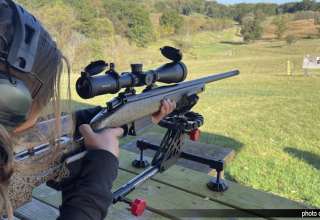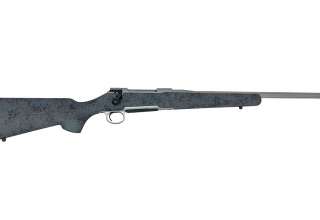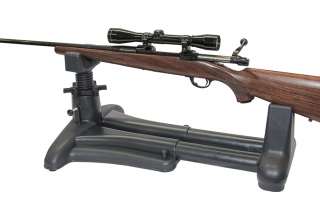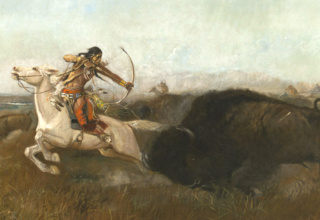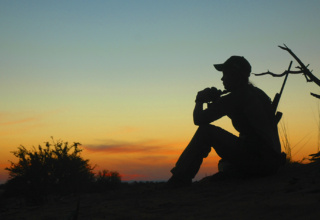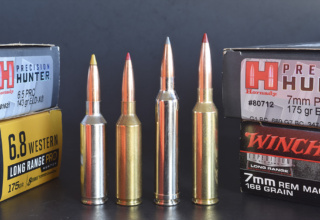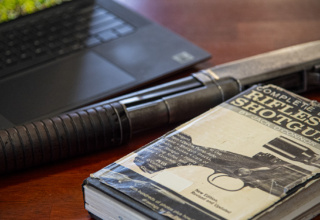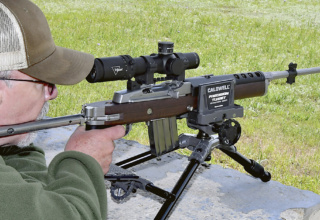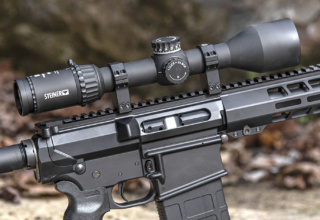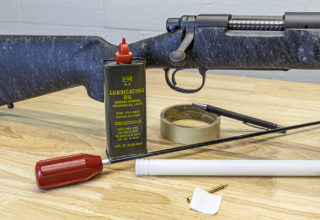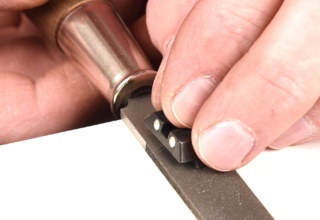It was too close to miss. But I did miss. By the third shot, I was shading high, then low. The kudu at last caught a softpoint and wilted. “Not a typical shot,” said my pal, charitably. Not my typical performance, I thought. But to say so would have been to whine. The results were mine to own.
 Had I practiced firing straight down a cliff face, this show might have been shorter. My friend’s .270 was zeroed. I had checked that right away. And I knew that bullets fired uphill or down strike higher that when fired the same distance horizontally, because gravity affects only the horizontal component of their arcs. But my marksmanship wasn’t up to the challenge. My preseason shooting had been limited to sage flats. I expect steep shots in goat country, not on Africa’s veldt!
Had I practiced firing straight down a cliff face, this show might have been shorter. My friend’s .270 was zeroed. I had checked that right away. And I knew that bullets fired uphill or down strike higher that when fired the same distance horizontally, because gravity affects only the horizontal component of their arcs. But my marksmanship wasn’t up to the challenge. My preseason shooting had been limited to sage flats. I expect steep shots in goat country, not on Africa’s veldt!
In truth, tough shot angles can pop up anywhere. And instead of firing from your belly or fanny, you may have to stand. Steadying a rifle offhand is tough enough if you’re aiming across a prairie. Add a steep angle, and the task is tougher still.
Many of us who’ve endured offhand in competition call it, not affectionately, awfulhand. No one in his or her right mind practices standing when others look on – which is why few hunters shoot standing well. Once, at a range where hunters were zeroing rifles for a hunt, I hung a target the size of elk vitals at 100 yards and asked each of the 40-odd riflemen to take one shot offhand at this beachball mark. Fewer than a dozen hit it. Several missed the backer, roughly the size of a kitchen stove. All these hunters would be afield opening morning. None volunteered to stay on the range and practice their offhand shooting.
 Humiliation builds character. But if that holds no appeal, you can hone shooting skills from field positions alone. Solitude also helps you focus on fundamentals. Shunning practice altogether, like firing only across a bench, is a popular but pointless alternative. Hunters who don’t fire from hunting positions set themselves up to miss or, worse, to cripple game.
Humiliation builds character. But if that holds no appeal, you can hone shooting skills from field positions alone. Solitude also helps you focus on fundamentals. Shunning practice altogether, like firing only across a bench, is a popular but pointless alternative. Hunters who don’t fire from hunting positions set themselves up to miss or, worse, to cripple game.
Though offhand drills – and situps and changing engine oil and trips to the dentist – don’t rank at the top of feel-good charts, they have long-term benefits. Firing at game, I’ll lie prone whenever possible, a taut sling squeezing jitters from my sight. Sitting is second choice. When kneeling, the 3-to-9 o’clock wobble is annoying. When brush or the curve of the earth, or urgency, limits me to offhand, any improvised support is welcome. Sadly, there’s seldom a tree or a set of shooting sticks ready at my elbow.
 I recently found a device that can help, at least in practice. The people at MTM call it their High-Low Shooting Table. Like other shooting accessories in their lineup, it’s a thoughtfully designed item. From handloading trays to cartridge boxes and dry-boxes, shooting rests to gunsmithing maintenance centers and gun vises, they’re cleverly fashioned of sturdy polymer. Ditto the bore guides, clay target throwers – and arrow cases that have protected my broadheads in overseas travel.
I recently found a device that can help, at least in practice. The people at MTM call it their High-Low Shooting Table. Like other shooting accessories in their lineup, it’s a thoughtfully designed item. From handloading trays to cartridge boxes and dry-boxes, shooting rests to gunsmithing maintenance centers and gun vises, they’re cleverly fashioned of sturdy polymer. Ditto the bore guides, clay target throwers – and arrow cases that have protected my broadheads in overseas travel.
The High-Low table has a 17×33-inch surface that accommodates right- and left-hand shooters. A carrying handle is molded in. A separate tripod (with carrying strap) supports the table. Its independently adjustable legs have stake-style steel feet. Quick-twist leg locks and screw clamps help you level the table quickly on hillside or marsh edge. The tripod adjusts from 18 to 55 inches in height.
[quotes quotes_style=”bquotes” quotes_pos=”center”]
The Earth Isn’t Flat! You know that. It still seems flat, to the horizon. But maybe not where game steps into your sights.
[/quotes]
Convenience spurs compliance. When visions of offhand practice start nagging me at night, I’m further encouraged by a table that puts cartridges and a rifle rest at chest height for easy reach, a spotting scope near enough to my eye that a tilt of the head will give me a target check. No need to get out of position to load or look. Also, the High-Low can be easily moved away from other shooters on fixed benches. When thoroughly dispirited by my offhand performance, I can regain face by dropping the tripod to kneeling height and adding MTM’s Quick Rest to support the rifle.
Of course, you can use this or any other sturdy table – or the stone-solid portable bench by Royal Stuckey, out of Wyoming – to zero your rifle or test loads. But firing without a seat, from varying heights and angles, with and without a rest, you aim, fire and cycle as you must when field conditions preclude a deliberate shot from a low supported position. An orchard prop set at table’s edge replicates a tree for me, commonly the only help I get in the woods, kneeling or standing.
 Hunters firing hard-kicking rifles have found high tables mitigate recoil. Over a standing rest, you flex to the jab of recoil, from clavicle to ankles. Planted on a bench seat, your fanny doesn’t move. You’re bent over the rifle, shoulder forward. Recoil compresses your torso. There’s little flex, only pain that tells you there should be!
Hunters firing hard-kicking rifles have found high tables mitigate recoil. Over a standing rest, you flex to the jab of recoil, from clavicle to ankles. Planted on a bench seat, your fanny doesn’t move. You’re bent over the rifle, shoulder forward. Recoil compresses your torso. There’s little flex, only pain that tells you there should be!
A standing rest is a good way to zero double rifles and big-bore, iron-sighted repeaters for other reasons. The accurate reach of doubles is well inside 100 yards; the practical range for big-bore repeaters without scopes isn’t much greater. You should be able from a standing rest to keep shots inside 3 minutes of angle, maybe 2. That’s tight enough to establish a group center and make needed adjustments. Firing offhand, you use the position and “hold” you’ll almost surely use on a hunt. You won’t be prone behind a bipod cradling that .45-70 saddle gun, or a twin-barrel .500 Nitro Express! So standing, the zero you get will reflect shooting conditions afield.
Be warned: With or without a tall table or a standing rest, offhand practice, especially at steep or awkward angles, can embarrass you if done in public. It will also help you get more game!


